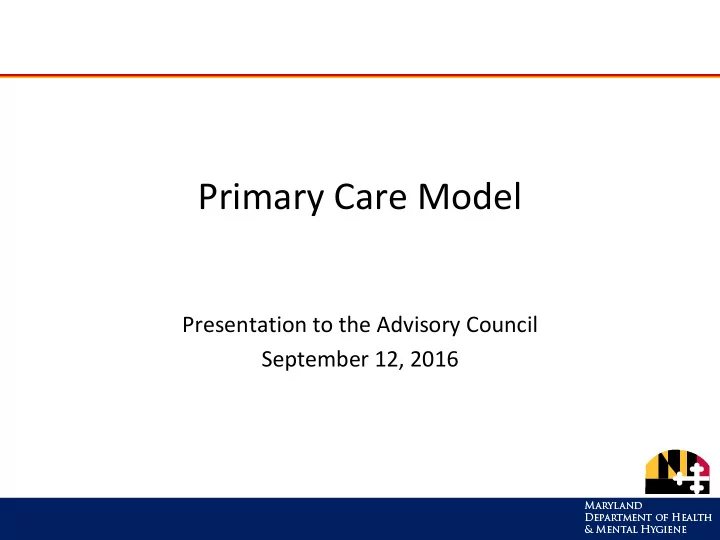

Primary Care Model Presentation to the Advisory Council September 12, 2016
CONCEPT 2
Guiding Principles • Broad-based provider participation design- Patient Designated Provider • Enhanced population health management functions • All-payer, incrementally in alignment with Phase 2 of waiver • Care Management as a necessary element, embedded where able • Regional Care Coordination Resources • All Payer Model/TCOC alignment including Duals • Person and Family Centered base of care • Aligned and consistent set of quality/outcome metrics • Efficient data exchange and robust, connected tools for providers • Financial and non-financial incentives to encourage practice transformation • Quality and cost transparency for providers and patients 3
Hospital Maryland Primary Care Model Chronic Care Initiative (CCIP ) High Risk Patients, Rising Risk Patients Population PQI Bonuses Care Management Resources & Health Mgmt/HIT Infrastructure xx% CM Funds Administrator (State Level) CRISP Medicare + Resource Manager (Regional) Medicaid + Commercial CM Care Coordination PDP embeds or requests unembedded CM Payments resources based on PT need CM Person-Centered xx% CM Funds Home (PCH) Quality Payments at Risk Patient-Designated Provider (PDP) (MACRA qualifying) PATIENT (PT) Visit/Non-Visit-based Specialists Payments Behavioral Health Providers Traditional SNF Providers PCPs Ambulatory Care Providers 4 LTSS Providers Chronic HH Providers
Key Elements of the Model • Primary Care Home/ Patient-designated Provider – – the most appropriate provider to manage the care of each patient, provides preventive services, coordinates care across the care continuum, and ensures enhanced access. Most often this is a PCP but may also be a specialist, behavioral health provider, or other depending on patients health needs – Practice – means an individual provider or group of providers that deliver care as a team to a panel of patients. Practices may span multiple physical sites in the community • Care Coordination/Management Infrastructure – a multi-level structure that coordinates care management for patients and ensures appropriate deployment of resources • Incenting Value-based Care – Payers • CM Funding • Quality Funding • Upfront non-Visit based payments- facilitates alternative care delivery – Hospitals - chronic Care bonus pool alignment with community • Population Health Management/HIT – key data exchanged to all care participants through CRISP, using tools and analytics for risk stratification, improved care, and efficient connection to other services 5
PRACTICE TRANSFORMATION 6 6
Driving Practice Transformation Care Managers Practice Regional Care Management Person-Centered Transformers/Transformation Organization Home/Practice Programs Performance Data 7
Practice Transformation Design Customized CPC+ like design eCQM tool, State agency Risk Aligned metrics Financial Structures Care Incentives Coordination Care Management Health Care Payments Infrastructure Plans Management Core Resources, Quality infrastructure Metrics , & Agents Practices Hospitals & Quality ACOs Payments Marylanders Practice Performance Transformation Data Resources & Agents Practice Transfor- Non-Visit- Core Practice mation based Functions Network Payments APCD 8 CRISP HIE, CRISP ICN Services
What/Who is Transforming the Practice? Entities • Coordinating Entity (CE) – serves as the financial and data management center for all Regional Care Management entities including – Administers payments from payers to regional entity and person-centered homes – Runs program analytics including risk identification and stratification – Connects with various programs/model • Regional entity (e.g. an ACO, RP, or CIN) – Organizes, contracts, and deploys CM resources – Serves as transformation resource and Learning Network outlet – Provides access to medical and non-medical resources – Ensures continuity across providers and single CM for ease of experience for patient, utilizing CRISP and CE tools • CRISP – state designated HIE that provides essential point of service information for care decisions, care coordination data, population health management data, and other key information and connections Agents • Care Managers - An individual with knowledge of community resources to address non-medical needs, whose efforts are integrated with pharmacists, therapists, specialists and primary care; a trusted advocate who shares important data via CRISP in order to keep patients safe as they navigate across settings of care and different health systems • Transformation agents and programs - the individual and entity (contracted) that takes the lead on standard elements of transformation for practices, has staff and programs housed within the regional care management entities, and provides on-site technical assistance to practices 9
CARE MANAGEMENT INFRASTRUCTURE 10 10
Regional Care Management Organization at the Center CE CRISP Care Management Entities Regional Partnerships Health Systems/Hospitals ACOs Health Plans Supply CMs Local Heath Departments Pharmacy entities Others Regional Care Management Organization RN MA CNA PharmD CHW LCSW CM CM CM PCH PCH PCH 11
Regional Care Management Services Regional Care Management Organization provides the following services: 1.Resource Deployment and Contracting a) Coordination of primary CM resources – embedded and non-embedded (RN, MA, etc) b) Second level of CM resources – non traditional care management resources (PharmD, CHW, etc) based on demand by primary care managers through a referral process 2.Practice transformation training and network 3.Direct delivery of services in the community, e.g., non-office based primary care for high utilizers using CRISP hot-spotting tools?? a) Align with HSCRC Care Coordination Infrastructure funding for Regional Partnerships and health systems to provide community based care coordination and population health 4.Real-time portal for provider of resource offerings 12 5.Interface with CRISP and Coordination Entity for timely data
PAYMENT FLOWS 13
Funding the Primary Care Model Care Management Funding Quality Payments Upfront- at risk Care Redesign Visit-based Payments Advance non visit and discounted FFS MACRA/Quality Payment Program – AAPM Bonus At risk 14
Recommend
More recommend